Scone
A scone (/skoʊn/, also UK: /skɒn/) is a baked good, usually made of wheat, or oatmeal with baking powder as a leavening agent and baked on sheet pans. A scone is often slightly sweetened and occasionally glazed with egg wash.[1] The scone is a basic component of the cream tea. It differs from teacakes and other types of sweets that are made with yeast. Scones were chosen as the Republic of Ireland representative for Café Europe during the Austrian Presidency of the European Union in 2006, while the United Kingdom chose shortbread.
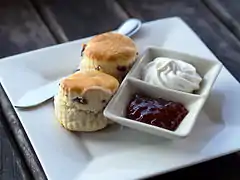 | |
| Type | Pastry |
|---|---|
| Place of origin | United Kingdom |
| Main ingredients | Wheat, barley, or oatmeal |
Lexicology

The pronunciation of the word within the English-speaking world varies, with some pronouncing it /skɒn/ (rhymes with "swan"),[2] and others /skoʊn/ (rhymes with "tone").[3] The dominant pronunciation differs by area. The pronunciation rhyming with "tone" is strongest in the Midlands and southern Ireland, though it seems to have less prominent patches in Cornwall and Essex. The pronunciation rhyming with "swan" is strongest in Northern England and Scotland, although this also seems to be the favoured pronunciation in Southern England, Wales, the Home Counties, and East Anglia.[4][5] Natives of the Republic of Ireland and the United States mainly use the /skoʊn/ pronunciation.[6] British dictionaries usually show the /skɒn/ form as the preferred pronunciation, while recognising the /skoʊn/ form.[2]
The difference in pronunciation is alluded to in a poem:
The Oxford English Dictionary reports that the first mention of the word was in 1513.
The origin of the word scone is obscure and may derive from different sources. That is, the classic Scottish scone, the Dutch schoonbrood or "spoonbread" (very similar to the drop scone), and possibly other similarly-named quick breads may have made their way onto the British tea table, where their similar names merged into one. Thus, scone may derive from the Middle Dutch schoonbrood (fine white bread), from schoon (pure, clean) and brood (bread),[9][10] or it may derive from the Scots Gaelic term sgonn meaning a shapeless mass or large mouthful. The Middle Low German term schöne meaning fine bread may also have played a role in the origination of this word. And, if the explanation put forward by Sheila MacNiven Cameron is true, the word may also be based on the town of Scone (/skuːn/ (![]() listen)) (Scots: Scuin, Scottish Gaelic: Sgàin) in Scotland, the ancient capital of that country – where Scottish monarchs were crowned, and on whose Stone of Scone the monarchs of the United Kingdom are still crowned today.[11]
listen)) (Scots: Scuin, Scottish Gaelic: Sgàin) in Scotland, the ancient capital of that country – where Scottish monarchs were crowned, and on whose Stone of Scone the monarchs of the United Kingdom are still crowned today.[11]
History
It is believed that historically scones were round and flat, usually as large as a medium-sized plate. It was made and baked on a griddle (or girdle, in Scots), then cut into triangular sections for serving. Today, many would call the large round cake a bannock. In Scotland, the words are often used interchangeably.[12]
When baking powder became available to the masses, scones began to be the oven-baked, well-leavened items we know today.[13] Modern scones are widely available in British bakeries, grocery stores, and supermarkets. A 2005 market report estimated the UK scone market to be worth £64m, showing a 9% increase over the previous five years. The increase is partly due to an increasing consumer preference for impulse and convenience foods.[14]
Scones sold commercially are usually round, although some brands are hexagonal as this shape may be tessellated for space efficiency. When prepared at home, they may take various shapes including triangles, rounds and squares.[15] Baking scones at home is often closely tied to heritage baking. They tend to be made using family recipes rather than recipe books, since it is often a family member who holds the "best" and most-treasured recipe.[16]
Varieties
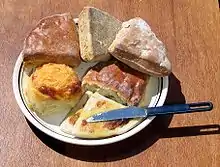
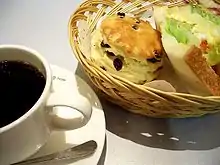
British scones are often lightly sweetened, but may also be savoury. They frequently include raisins, currants, cheese or dates. In Scotland and Ulster, savoury varieties of scone include soda scones, also known as soda farls, sour dough scones known as soor dook scones made with sour milk, and potato scones, normally known as tattie scones, which resemble small, thin savoury pancakes made with potato flour. Potato scones are most commonly served fried in a full Scottish breakfast or an Ulster fry.
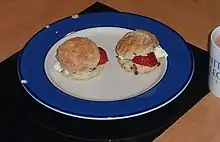
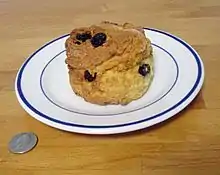
The griddle scone (or "girdle scone" in Scots) is a variety of scone which is cooked on a griddle (or girdle) on the stove top rather than baked in the oven. This usage is also common in New Zealand where scones of all varieties form an important part of traditional colonial New Zealand cuisine.
Other common varieties include the dropped scone, or drop scone, like a pancake, after the method of dropping the batter onto the griddle or frying pan to cook it, and the lemonade scone, which is made with lemonade and cream instead of butter and milk. There is also the fruit scone or fruited scone, which contains currants, sultanas, peel and glacé cherries, which is just like a plain round scone with the fruit mixed into the dough. To achieve lightness and flakiness, scones may be made with cream instead of milk.
In some countries one may also encounter savoury varieties of scone which may contain or be topped with combinations of cheese, onion, bacon, etc.
Scones can be presented with various toppings and condiments, typically butter, jam and cream. Strawberries are also sometimes used.
Regional variations
Australia
Pumpkin scones, made by adding mashed cooked pumpkin to the dough mixture, had increased exposure during the period when Florence Bjelke-Petersen was in the public eye.[17][18] Date scones, which contain chopped dried dates, can also be found in Australia. Another old style of cooking scones, generally in the colder months, is to deep-fry or deep pan-fry them in dripping or oil, when they are called "puftaloons".
Germany & Hungary
In Hungary, a pastry very similar to the British version exists under the name "pogácsa". The name has been adopted by several neighbouring nations' languages. (E.g. Pogatsche in German.) Pogácsa is almost always savoury and served with varied seasonings and toppings, like dill and cheese.
New Zealand
Cheese scones are a popular snack sold in cafes or tea shops, where they are commonly served toasted with butter.[19] They are featured in the Edmonds Cookery Book and make up a part of kiwiana.
South Africa
Scones are commonly served with clotted cream and jam; grated cheddar cheese is another popular accompaniment.
South America
Scones are quite popular in Argentina as well as Uruguay. They were brought there by Irish, English and Scottish immigrants and by Welsh immigrants in Patagonia (Britons are the third largest foreign community in Argentina).[20] They are usually accompanied by tea, coffee or mate.
United States
Scones under that name often appear in coffee houses. They may be sweet, often containing fruit such as blueberries or sultanas, or else such flavorings as cinnamon or chocolate chips. US scones are usually actually closer to British Rock cakes. They are heavy, dry and crumbly, usually in a triangular or irregular shape.
In Idaho and Utah, the bread products locally called "scones" are similar to Native American frybread or New Orleans beignets and are made from a sweet yeast dough, with buttermilk and baking powder or soda added, and they are fried rather than baked. They are customarily served with butter and either honey or maple syrup.[21]
Cultural references
The plot of Season 10, Episode 3 of Curb Your Enthusiasm[22] involves a heated dispute about the proper texture for scones.
Other usage
In Scots the verb scon means to crush flat or beat with the open hand on a flat surface, and "scon-cap" or "scone-cap" refers to a man's broad flat cap or "bunnet".
In Australia, scone can be a slang term for the head, usually referring to the crown region.
See also
| Wikimedia Commons has media related to Scones. |
| Wikibooks Cookbook has a recipe/module on |
| Look up scone in Wiktionary, the free dictionary. |
References
- Hollywood, Paul. "Paul Hollywood's scones". BBC. Retrieved 22 September 2015.
- Wells, J. C. "Pronunciation Preferences in British English: a new survey". University College London, 1998
- Boult, Adam (2 November 2016). "Survey reveals 'correct' way to pronounce scone" – via www.telegraph.co.uk.
- editor, Robin McKie Observer Science (22 April 2017). "Do you pronounce 'scone' to rhyme with 'cone' or 'gone'? It depends where you're from" – via www.theguardian.com.CS1 maint: extra text: authors list (link)
- "Cambridge app maps decline in regional diversity of English dialects". University of Cambridge. 26 May 2016.
- Jacobs, F. "" 2016
- "Cracked Quatrains". Punch. Punch Publications Ltd. 144: 253. 1913. Retrieved 2 January 2015.
- Drifte, Collette; Jubb, Mike (2002). A Poetry Teacher's Toolkit: Rhymes, Rhythms, and Rattles. London: David Fulton Publishers. p. 106. ISBN 1-85346-819-3.
- Douglas, Sheila. "The Scots Language and Its European Roots" (PDF).
- Harper, Douglas (2001). "Scone". Online Etymology Dictionary. Dictionary.com. Retrieved 19 November 2009.
- Weiner and Albright. Simply Scones. St. Martin's Press, 1988, p. 3.
- Ingram, Christine; Shapter, Jennie (2003). Bread: the breads of the world and how to bake them at home. (Originally published as The World Encyclopedia of Bread and Bread Making.) London: Hermes House. p. 54. ISBN 0-681-87922-X.
- Smith, Delia (27 March 2007). Delia's Complete Cookery Course. London: BBC Books. ISBN 978-0-563-36249-4.
- "Back-bite free scone mix launched in UK". bakeryandsnacks.com. 28 June 2005. Retrieved 22 September 2015.
- "The History of Scones". Food History. The Kitchen Project. 1 March 2001. Retrieved 9 September 2008.
- Goldman, Marcy (2007). A Passion for Baking. Birmingham, Alabama: Oxmoor House, Inc. pp. 85. ISBN 978-0-8487-3179-3.
- "Flo Bjelke - Petersen - Pumpkin Scones". www.australianbiography.gov.au.
- McInerney, Sarah (5 May 2011). "How to bake the perfect scone". The Sydney Morning Herald. Fairfax Media. Archived from the original on 7 May 2016. Retrieved 7 January 2017.
- "On the hunt for the best scones in town". Stuff.
- "Qué comian".
- Sokolov, Raymond (June 1985). "Everyman's muffins; Includes recipes". Natural History. 94: 82. as found here
- Curb Your Enthusiasm: Artificial Fruit (HBO television broadcast Feb. 2, 2020) (Season 10, Episode 1).